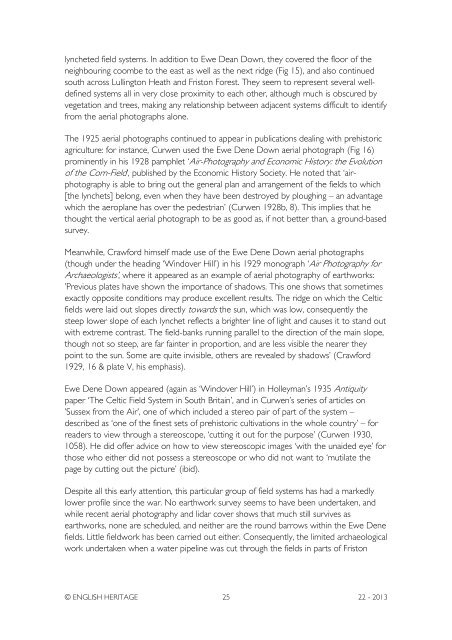Aerial Investigation and Mapping Report - English Heritage
Aerial Investigation and Mapping Report - English Heritage
Aerial Investigation and Mapping Report - English Heritage
Create successful ePaper yourself
Turn your PDF publications into a flip-book with our unique Google optimized e-Paper software.
lyncheted field systems. In addition to Ewe Dean Down, they covered the floor of theneighbouring coombe to the east as well as the next ridge (Fig 15), <strong>and</strong> also continuedsouth across Lullington Heath <strong>and</strong> Friston Forest. They seem to represent several welldefinedsystems all in very close proximity to each other, although much is obscured byvegetation <strong>and</strong> trees, making any relationship between adjacent systems difficult to identifyfrom the aerial photographs alone.The 1925 aerial photographs continued to appear in publications dealing with prehistoricagriculture: for instance, Curwen used the Ewe Dene Down aerial photograph (Fig 16)prominently in his 1928 pamphlet ‘Air-Photography <strong>and</strong> Economic History: the Evolutionof the Corn-Field’, published by the Economic History Society. He noted that ‘airphotographyis able to bring out the general plan <strong>and</strong> arrangement of the fields to which[the lynchets] belong, even when they have been destroyed by ploughing – an advantagewhich the aeroplane has over the pedestrian’ (Curwen 1928b, 8). This implies that hethought the vertical aerial photograph to be as good as, if not better than, a ground-basedsurvey.Meanwhile, Crawford himself made use of the Ewe Dene Down aerial photographs(though under the heading ‘Windover Hill’) in his 1929 monograph ‘Air Photography forArchaeologists’, where it appeared as an example of aerial photography of earthworks:’Previous plates have shown the importance of shadows. This one shows that sometimesexactly opposite conditions may produce excellent results. The ridge on which the Celticfields were laid out slopes directly towards the sun, which was low, consequently thesteep lower slope of each lynchet reflects a brighter line of light <strong>and</strong> causes it to st<strong>and</strong> outwith extreme contrast. The field-banks running parallel to the direction of the main slope,though not so steep, are far fainter in proportion, <strong>and</strong> are less visible the nearer theypoint to the sun. Some are quite invisible, others are revealed by shadows’ (Crawford1929, 16 & plate V, his emphasis).Ewe Dene Down appeared (again as ‘Windover Hill’) in Holleyman’s 1935 Antiquitypaper ‘The Celtic Field System in South Britain’, <strong>and</strong> in Curwen’s series of articles on’Sussex from the Air’, one of which included a stereo pair of part of the system –described as ‘one of the finest sets of prehistoric cultivations in the whole country’ – forreaders to view through a stereoscope, ‘cutting it out for the purpose’ (Curwen 1930,1058). He did offer advice on how to view stereoscopic images ‘with the unaided eye’ forthose who either did not possess a stereoscope or who did not want to ‘mutilate thepage by cutting out the picture’ (ibid).Despite all this early attention, this particular group of field systems has had a markedlylower profile since the war. No earthwork survey seems to have been undertaken, <strong>and</strong>while recent aerial photography <strong>and</strong> lidar cover shows that much still survives asearthworks, none are scheduled, <strong>and</strong> neither are the round barrows within the Ewe Denefields. Little fieldwork has been carried out either. Consequently, the limited archaeologicalwork undertaken when a water pipeline was cut through the fields in parts of Friston© ENGLISH HERITAGE 25 22 - 2013

















